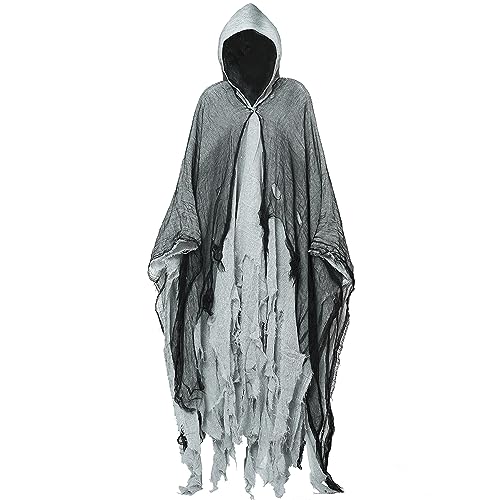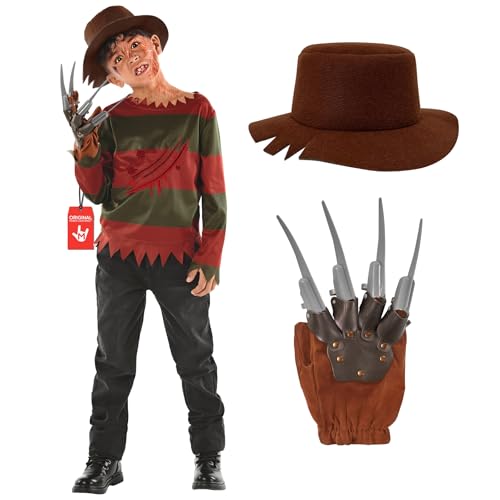Halloween costumes are often associated with elements of fear and the macabre. But why exactly are these costumes so scary? Dive into the fascinating reasons behind the frightful nature of Halloween costumes, exploring factors from historical origins to psychological appeal. By understanding the underlying aspects that make Halloween costumes spooky, we can appreciate the cultural context, symbolism, and entertainment value they hold.
1. Historical Origins of Halloween: Halloween has ancient roots in Celtic festivals like Samhain, where people believed that spirits could cross over into the mortal realm. Wearing costumes and masks served as protection against these spirits, eventually evolving into a tradition of scary disguises.
2. Embracing the Fear Factor: Halloween is an occasion where people indulge in thrilling experiences, seeking adrenaline rushes and the excitement of being scared. Scary costumes allow individuals to embrace the fear factor and step out of their comfort zones.
3. Psychological Appeal of Fear: Fear triggers an innate survival response in our brains, and for some, experiencing controlled fear can be exhilarating. Halloween costumes provide a safe environment to explore these emotions, offering a sense of excitement and thrill.
4. Cultural Context and Symbolism: Halloween costumes often draw inspiration from cultural myths, legends, and supernatural creatures. They can represent fears, nightmares, and archetypal characters, making them both relatable and captivating.
5. Role of Imagination and Fantasy: Halloween allows individuals to tap into their imagination and embrace fantasy. Scary costumes transform people into fantastical beings, monsters, or creatures, providing an opportunity to step into a different world.
6. Creating an Entertaining Experience: Ultimately, Halloween costumes aim to create an entertaining experience for both those wearing the costumes and those observing them. The element of fear adds suspense, surprise, and anticipation, enhancing the overall enjoyment of Halloween festivities.
By exploring the reasons behind the scariness of Halloween costumes, we can gain a deeper appreciation for this beloved tradition and the emotions it evokes.
Key takeaway:
- Historical Origins of Halloween: The scary element of Halloween costumes can be traced back to the historical origins of the celebration, which involved warding off evil spirits and embracing the unknown.
- Psychological Appeal of Fear: Scary Halloween costumes tap into our innate fear responses, providing an adrenaline rush and a sense of excitement and thrill.
- Cultural Context and Symbolism: Scary costumes also hold cultural significance, representing supernatural beings, mythical creatures, and cultural icons that embody fear and darkness.
Why Are Halloween Costumes Scary?
Discover the intriguing reasons behind the spine-chilling allure of Halloween costumes. Uncover the historical origins that contribute to their scare factor, explore the psychological appeal of fear, and immerse yourself in the cultural symbolism that surrounds these enigmatic ensembles. Dive into the realm of imagination and fantasy, where costumes become a gateway to thrilling experiences. Join us as we unravel the mysterious allure of Halloween costumes, leaving you captivated by their storytelling potential and entertainment value.
Historical Origins of Halloween
The historical origins of Halloween can be traced back to the ancient Celtic festival, Samhain. Samhain marked the end of the harvest season and the beginning of winter, a time associated with death and darkness. The Celts believed that on October 31st, the boundary between the living and the dead was blurred, and spirits roamed the earth.
During Samhain, the Celts lit bonfires and wore costumes to ward off roaming spirits. They thought that disguising themselves would prevent spirits from recognizing or blending in with them. This tradition evolved into today’s Halloween costumes.
Over time, as Christianity merged with pagan traditions, the festival of Samhain became part of the Christian holiday, All Hallows’ Eve or Halloween. Costumes continued to be worn, including outfits representing saints or religious figures.
Today, Halloween and costume-wearing celebrate imagination, creativity, and the thrill of pretending to be someone else. Whether it’s a ghost or a superhero, Halloween costumes let us embrace the spirit of the holiday and immerse ourselves in a world of fantasy.
Fact: The tradition of trick-or-treating on Halloween originated from the medieval practice of “souling.” On All Hallows’ Eve, poor people would go door-to-door, offering prayers for the deceased in exchange for food. This eventually became the modern tradition of children collecting candy while dressed in costumes.
Embracing the Fear Factor
Embracing the fear factor in Halloween costumes adds excitement and thrill to the holiday. People actively seek out scary costumes because embracing fear triggers a physiological response, releasing adrenaline and increasing heart rate. By embracing the fear factor, individuals can experience heightened excitement.
Halloween costumes that embrace the fear factor often include blood, creepy masks, and eerie sound effects. These costumes immerse individuals in the world of horror and allow them to become frightening characters.
The fear factor in Halloween costumes also taps into the psychological appeal of fear. Humans naturally seek out thrilling and scary experiences, finding excitement in the unknown.
Psychological Appeal of Fear
Halloween costumes have a compelling psychological appeal due to fear. Fear has the power to elicit strong emotions and responses in the human brain, resulting in excitement and adrenaline rushes. The ability of scary costumes to instill fear in others is both thrilling and entertaining.
From a psychological standpoint, fear leads to the release of adrenaline and activates the fight-or-flight response, enhancing our senses and increasing our alertness. This intense experience can become addictive, driving some individuals to actively seek out scary costumes and haunted encounters.
Additionally, fear fosters a sense of unity and community. When people feel scared together, it creates a bonding experience and a sense of belonging. This is why Halloween is frequently celebrated in the company of friends and family, as a shared experience of being frightened.
Through the embrace of fear via scary costumes, individuals can confront their fears within a controlled environment. The act allows us to explore and overcome our deepest fears and anxieties without exposing ourselves to real danger.
Cultural Context and Symbolism
Cultural context and symbolism play a significant role in the creation and meaning of scary Halloween costumes. Halloween has its roots in ancient Celtic festivals, where the belief in a blurred boundary between the living and the dead took hold. As a result, Halloween has become closely associated with supernatural entities such as spirits and ghosts. Costumes serve as a representation of these beings, evoking fear and a sense of otherworldliness.
Halloween costumes carry symbolic value. They provide individuals with the opportunity to explore and express their deepest fears and darker desires within a safe and controlled environment. By donning the garb of monsters or witches, people can confront their anxieties and apprehensions while enjoying the thrill and exhilaration of Halloween festivities.
A compelling real-life story that exemplifies the cultural context and symbolism of Halloween costumes revolves around a woman named Sarah. Sarah held a deep fascination for the Aos Sí, mythical creatures originating from Irish folklore that are closely associated with Halloween. In her creative endeavor, Sarah crafted a homemade costume that authentically captured the essence of the Aos Sí, complete with intricate makeup and props. When she wore her masterpiece to a Halloween party, Sarah received much praise for her ingenuity and her ability to embody the cultural significance embedded in Halloween costumes. Her costume allowed her to fully immerse herself in the cultural context and symbolism of Halloween, sparking intriguing conversations about the history and enduring traditions of the holiday.
Role of Imagination and Fantasy
Imagination and fantasy play a crucial role in the creation and appeal of Halloween costumes. They offer individuals the opportunity to tap into their creativity and embody different personas. By dressing up as their beloved characters, people can immerse themselves in a world of make-believe, temporarily escaping reality and embracing a sense of excitement and awe.
Not only that, but imagination also nurtures a sense of community and connection during Halloween celebrations. It inspires people to come together and share the delight of dressing up and engaging in pretend play. Whether it involves attending parties or going trick-or-treating, the shared imagination and fantasy inherent in Halloween costumes foster camaraderie among participants.
Fantasy within Halloween costumes allows individuals to confront their fears within a safe and controlled environment. By donning spooky costumes, individuals experience a thrilling rush of adrenaline that satiates their intrigue with the unknown and the eerie. This combination of fear, imagination, and fantasy adds richness and intricacy to the Halloween tradition.
Creating an Entertaining Experience
Creating an entertaining experience is paramount when it comes to Halloween costumes. To achieve this, here are some valuable tips:
– Opt for a distinctive and captivating costume. Choose costumes that truly differentiate themselves and capture people’s attention, whether it’s through their design, concept, or execution.
– Infuse humor into your costume. Funny costumes always have great appeal and can effortlessly bring smiles and laughter to people’s faces.
– Embrace your creativity and originality. Steer clear of generic costumes and instead come up with something unexpected and rejuvenating. For more insights on why Halloween costumes are scary, check out why are Halloween costumes scary.
– Contemplate adding a surprise element. Consider incorporating small tricks or surprises into your costume, like hidden pockets or props, to amaze and entertain others.
– Engage and interact with fellow party-goers. Stay in character throughout the event, interact with others, and participate in group activities to enhance the overall entertainment factor.
Pro-tip: Don’t hesitate to think outside the box and take risks with your costume choices. The more unique and entertaining your costume is, the more memorable and enjoyable the experience will be for both yourself and others.
Frequently Asked Questions
Why are Halloween costumes scary?
Halloween costumes have traditionally been based on frightening supernatural or folkloric beings. This practice can be traced back to the belief that supernatural beings or the souls of the dead roamed the earth during the Halloween season. To ward off these beings, people would dress up in scary costumes or disguises.
What is the origin of Halloween costumes?
Halloween costumes have been worn since at least the 16th century. The custom of dressing up on Halloween may have originated from Celtic festivals such as Samhain and Calan Gaeaf, as well as the Christian observance of Allhallowtide. The belief that supernatural beings or the souls of the dead roamed the earth during this time led to the practice of wearing costumes as a form of protection.
When did adults start wearing Halloween costumes?
While Halloween costumes were initially worn mainly by young people, adults have increasingly started wearing them since the mid-20th century. This shift allowed Halloween costumes to become more diverse and cater to a broader range of interests and characters from mass media.
What were Halloween costumes like in the 18th century?
In the 18th century, Halloween costumes were traditionally based on frightening supernatural or folkloric beings. People would dress up in spooky costumes or disguises to protect themselves from these beings believed to roam the earth during Halloween. The costumes were often designed to be scary and evoke a sense of fear.
What role did church leaders play in Halloween costume traditions?
At some point, church leaders in the United States deemed spooky Halloween traditions as bad for the soul. Parents were instructed to remove anything scary from their children’s costumes. This shift in cultural perspective led to a decline in scary Halloween costumes and a shift towards more generic and non-scary costume options.
Why do some people prefer scary Halloween costumes?
Some people prefer scary Halloween costumes because they appreciate the traditional origins of the holiday. The belief in supernatural beings and the connection to the souls of the dead during Halloween creates a sense of mystery and excitement. Scary costumes allow individuals to embrace the spooky atmosphere and engage in the folklore and traditions associated with the holiday.
















